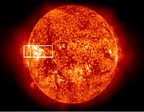

The VAULT Instrument Combines a Telescope and a Spectroheliograph

Click Here to View
a Detailed Image or
Click Here to View an Animation
Once VAULT is above the earth’s atmosphere, the front door opens, allowing solar radiation (light) to enter the telescope. Light is reflected off the primary mirror (which creates a virtual image of the sun) to the secondary mirror. The secondary mirror produces a real image of the solar disk at the spectroheliograph field stop (field stops limit the field of view of an optical instrument).
Light passing though the field stop is dispersed (separated into different wavelengths) and collimated (aligned) by the first grating, then reflected by the folding mirror to the second grating. The second grating produces a zero dispersion image of the solar disk with a bandpass of 150 angstroms. The bandpass is determined by the size of the second grating, the dispersion of the first grating, and the distance between the first and second gratings.
From the second grating, light is reflected to the CCD camera. The CCD camera has a narrowband filter in front of it to further reduce visible light.
| What
is a CCD Camera and How Does It Work? |
|
| A CCD camera uses a small, rectangular piece of silicon, called a charge-coupled device (CCD), to receive incoming light. This silicon wafer is a solid-state electronic component that has been micro-manufactured and segmented into an array of individual light-sensitive cells. Each cell is one element of the whole picture and is called a picture element, or "pixel." |
|
The CCD cells sense incoming light through the photoelectric effect, in which certain materials release an electron when hit with a photon of light. The electrons emitted within the CCD are stored within nonconductive boundaries (called electron wells), so that they remain within the area of the photon strike. As long as light is allowed to fall on a cell, electrons will accumulate in that pixel. When the source of light is removed (by closing VAULT’s front door), simple electronic circuitry and a microprocessor are used to unload the CCD array, count the electrons in each pixel, and store this information. This information is later processed by a computer to generate the images you see on this web site.
2003 U.S. Naval Research Laboratory
